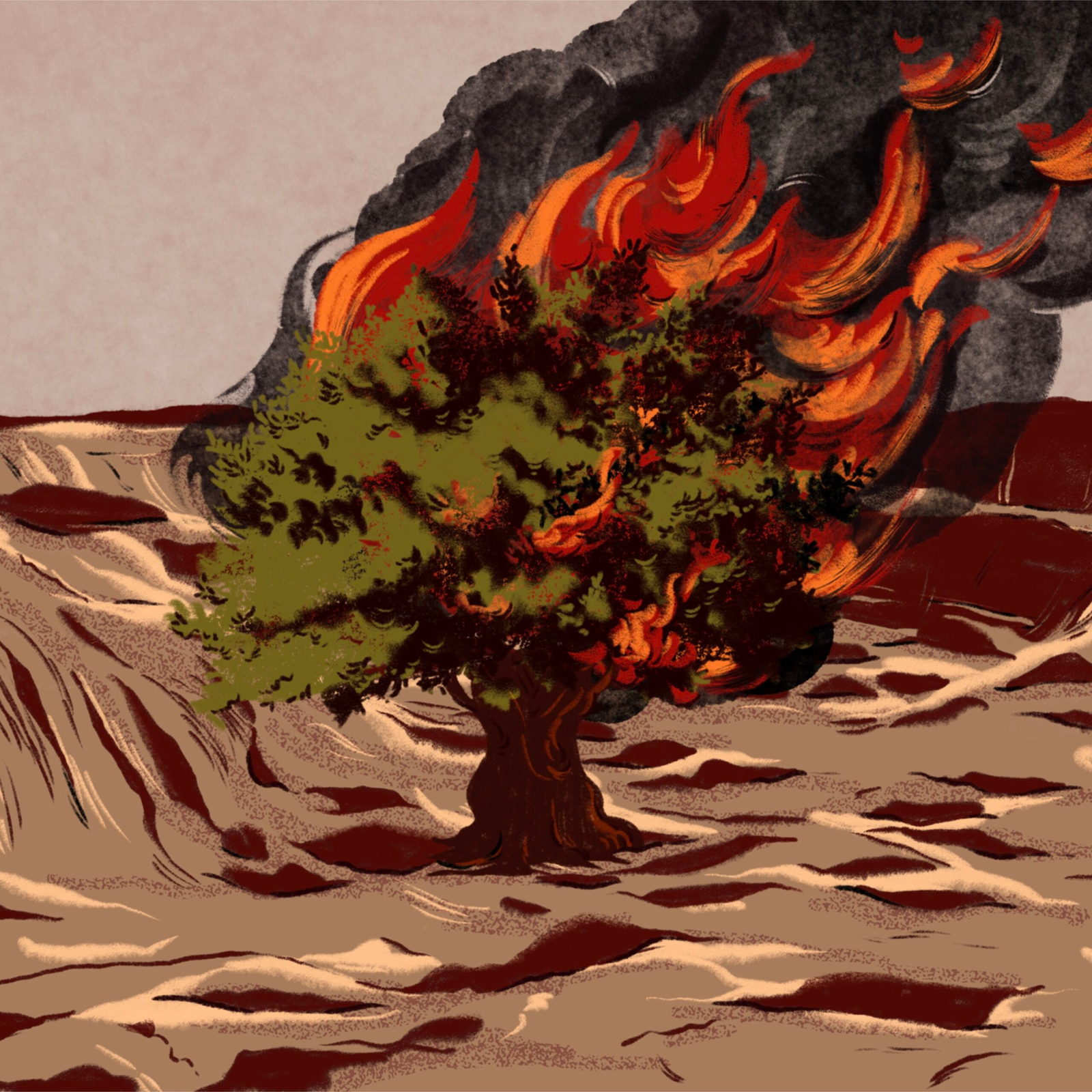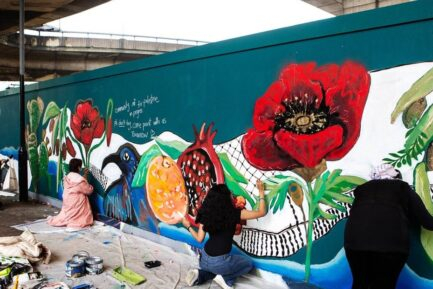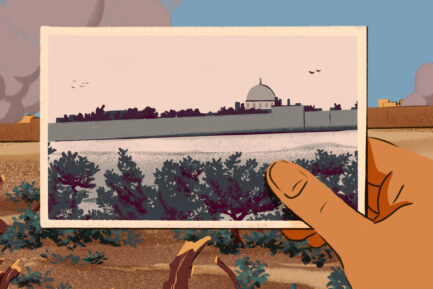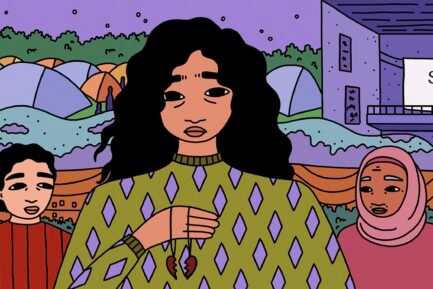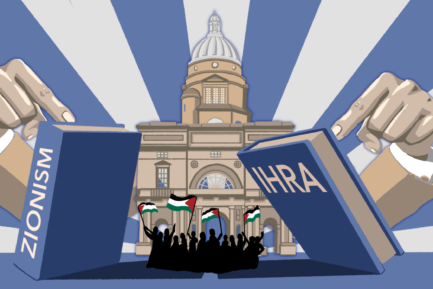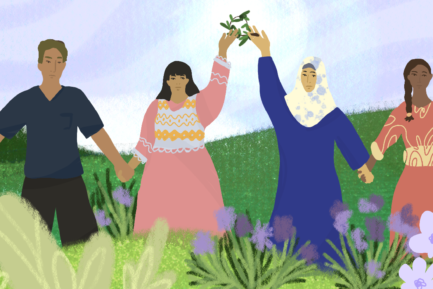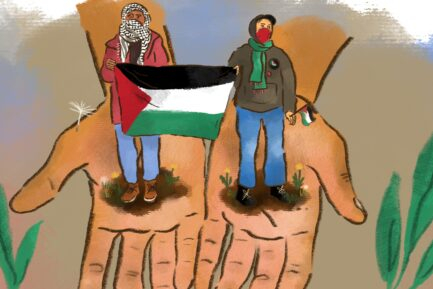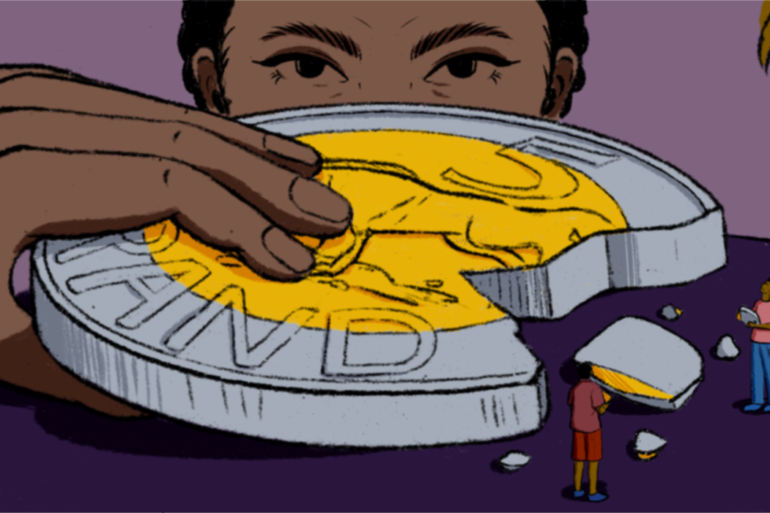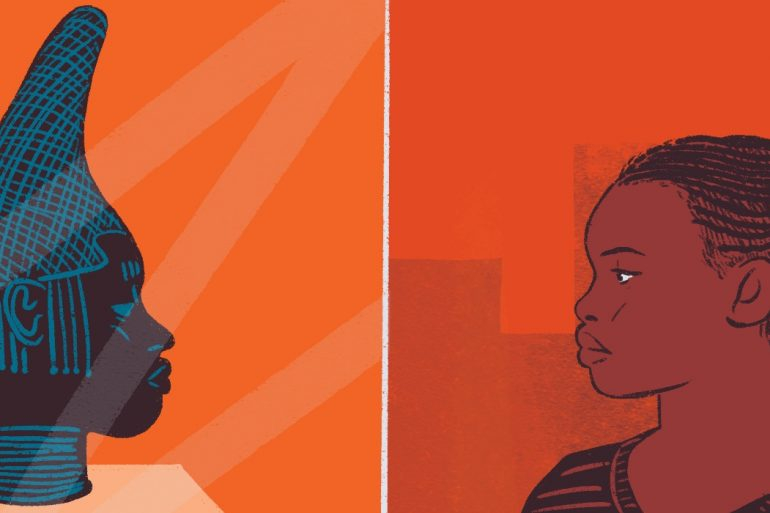For 75 years, Israel has colonised and exploited Palestinian land and people.
War crimes are being committed before our eyes, and airstrikes are creating ghosts of humans and infrastructure. And as the genocide continues, we are witnessing the lengths Israel will go to assert complete dominance over Palestinian resources. This pursuit not only kills civilians but also the environment: the freshness of the water, the fertility of the soil and the breathability of the air.
Though no two stories are the same, natural resources also play a role in the ongoing conflict in the Democratic Republic of Congo (DRC). This narrative begins in 1885 when King Leopold II first exploited the DRC’s natural resources when establishing the Congo Free State.
During the colonial period, materials such as rubber were sought out, but today, natural resources such as cobalt and copper are increasingly in demand by Western nations. These key resources are used in batteries, phones and home appliances. Cobalt, especially, is a necessary resource to power the transition to renewable energy. However ironically, the demand for these natural resources has contributed to environmental degradation, human displacement, and ongoing conflict.
Natural resources are global necessities, and it can be argued that the export and flow of natural resources form the foundation of globalisation. For this reason, not only do natural resources cement the interdependence between the Global North and South, but they are also political and economic assets that reveal the influence and presence of multiple nations in one nation.
Israel’s hegemony over Palestinian resources benefits other countries in the Global North who trade with Israel and, therefore, strengthens Israel’s ties with the West. This helps explain why particular nations like the US, are continuing to vote against a ceasefire. The Israeli Occupation cannot be seen simply as Israel vs Palestine. There is a multi-nation involvement in this occupation.
Similarly, what is taking place in the DRC is not simply a conflict within the DRC. Armed groups weaponise mines and areas rich with natural resources because these resources have international value. In the same way, if nations like the US and UK extract cobalt from the DRC to create their own green future, then the environmental damage and human costs associated with mine expansion must be held to global accountability.
Looking at the role natural resources play gives us a historical understanding of current global conflicts. Since colonialism, the Global North has benefited from the exploitation of natural resources without having to deal with the negative effects on the environment and people. This cycle upholds the notion that certain lands are more valuable than others, just as people are. The hypocrisy of this is that Western nations propagate values of independence, freedom, and, more recently, green futures, while simultaneously neglecting their own complicity in systemic injustices around the world.
Therefore, when we do understand the significance of natural resources in conflict, we recognise:
- Neocolonialism in Palestine and the DRC.
- Climate injustice and human injustice are interconnected.
- The Global North has been able to advance by exploiting and extracting resources found in the Global South and this cycle of inequality must end.
In examining this, we realise how those who created structures of inequality continue to profit from it and that environmental justice will aid the freedom, land reclamation, and full liberation of Indigenous people.
The occupation in Palestine
There are clear reasons why Palestine is a site of exploitation; its resources are needed for the advancement of Israel’s economy and relations with Western powers.
Concerning oil, it was confirmed in a 2019 UNC-TAD Report that occupied Palestinian territory lies above large reservoirs of oil and natural gas wealth, with The Levant Basin estimated to have 1.7 billion barrels of recoverable oil. This oil has a net value of $71 billion.
Beyond oil, there are also gas fields beneath Gaza including the Gaza Marine which holds over 1 trillion cubic feet of natural gas. This amount can not only power Palestine but could be used to advance the Palestinian economy if exported.
But, Palestinians have not been able to exert autonomy or control over their gas and oil reserves due to Israeli occupation, and instead, Israel exploits these resources for their gain. In fact, Israel has recently given 12 licences to six companies, including BP (UK), Eni (Italy) and Dana Petroleum (Korea), to allow them to explore natural gas off of the Mediterranean coast.
Israel hopes Tel Aviv will become an energy hub to export gas to Europe. In this alone, we see why Western nations have put monetary gain and power above Palestinian sovereignty.
It is clear that Israel’s colonisation of Palestine’s water and land is, again, for Israel’s economic advancement. Since 1967, Israel has appropriated over 100,000 hectares of Palestinian land, which has given them the ability to build residential and tourist settlements as well as establish international businesses and agricultural systems.
Businesses, agriculture and settlements are all dependent on water, which is why over 80% of water reserves in the West Bank are controlled by Israel. Essentially, Palestine has been exploited so that Israel’s “settlement enterprise” can thrive. But at what cost?
Environmental impact – Land and water
With the Israeli occupation and unfolding genocide, environmental deterioration has become inevitable. Explosives and Israel’s monopoly over water and land have had long-lasting effects on the environment.
I speak to Do’a Zayed, Project Manager at the Union of Agricultural Work Committees, who explains, “Prior to the occupation, Palestinians cultivated a diverse range of crops, including grapefruits, strawberries, Jaffa oranges, almonds, watermelons, eggplants, and, notably, olives, which covered 45% of the land in the occupied Palestinian territories.”
She continues, “The extensive uprooting, cutting, and burning of olive trees during the occupation have not only caused immediate economic losses for Palestinian farmers, but has also disrupted the ecological balance of the region’s landscape.”
Subscribe to shado's weekly newsletter
Exclusive event news, job and creative opportunities, first access to tickets and – just in case you missed them – our picks of the week, from inside shado and out.

Israel is attempting to revoke Palestinian sovereignty by burning trees and uprooting crops. In this, the very act of feeding and sustaining Palestinian life is threatened. It can be argued that these acts are attempts to starve Palestinians. The ecological fallout from these actions also makes it more and more difficult for Palestinians to rebuild, reestablish their roots and have any form of economic stability. This is evidence that Israel is using environmental violence as a means of causing direct harm to human beings.
In my interview with Kifaya Khraim, International Advocacy Coordinator at Women’s Center for Legal Aid and Counselling, she echoes similar experiences of land depredation due to the occupation.
She explains, “The industrial factories within the nearby Israeli settlement, particularly Amanuel, dispose of chemical waste that contaminates the soil. The polluted pickling water, infused with highly corrosive chemicals, transformed the land and other olive trees into withered fragments.”
The soil of Palestine has long endured the cost of explosives. Since 7th October alone, 25,000 tonnes of explosives have fallen on the Gaza Strip. These explosions cause soil damage and air pollution. With each attack, chemicals and greenhouse gases alter the atmosphere, whilst material build-up from the rockets depletes the ozone layer.
Do’a expands on this in our interview, “Upon detonation, the blast radius exposes the soil, water, and air to these hazardous substances. Despite the Gaza Strip’s compact size of only 41 km, it has endured decades of recurrent bombardment, resulting in significant environmental damage.”
It is now estimated that there will be a 20% decline in rainfall in the Eastern Mediterranean by 2050, alongside a gradual increase in seasonal temperature; this is influenced by the effects of explosives. These droughts are not only affecting the mortality of trees and shrubs, but are seriously impacting inland biodiversity.
Regarding water, Palestine experiences water scarcity, droughts, and pollution due to the imbalance in water sovereignty. The Coastal Aquifer, once the primary source of freshwater in Gaza, is now contaminated. Sustained attacks have resulted in irregular or non-existent fuel and electrical supply and the closure of sewage treatment plants. This means wastewater is emptied into the sea, and the seawater enters the aquifer.
In Gaza today, 97% of water doesn’t meet the World Health Organisation’s water quality standards.
Human impact – Ill health and displacement
The quality of life for Palestinian people is intrinsically linked to their relationship with the environment around them. The colonisation of resources and continued environmental violence have had dangerous consequences for Palestinian health and well-being.
Kifaya speaks particularly about the impact water contamination has had on Palestinian women living near Israeli settlements, “Maryam, 55, along with her neighbours, face daily suffering caused by wastewater discharged by Israeli settlements,” they recall. “The polluted water, originating from the settlements and their factories, quarries, and leather industry, poses significant health risks, especially for children and pregnant women. This includes skin rashes and poisoning.”
Women who live near Israeli settlements are also victims of settler violence and intimidation, with soldiers throwing stones at Palestinian-owned farms or using hazardous tear gas on them.
Kafir explains, “Sharifa, a 57-year-old mother, developed cancer as a result of her prolonged exposure to toxic tear gas used by Israeli forces. One time, a significant amount of tear gas was thrown near her house, and she lost consciousness and awoke in a hospital, where she remained under treatment for a week, vomiting blood. Medical examinations revealed that she suffered from stomach cancer due to the irritation caused by the constant exposure to tear gas.”
Sharifa’s story is not hers alone, “Women in the Gaza strip who live near the bordering area and mostly work in farming have reported the IOF’s constant bombardment of tear gas and other unknown gases at their lands and homes. The women testified that these gases had resulted in respiratory diseases to many of their family members.”
Events like these lead to displacement as Palestinians flee sites of violence, but the overpopulation of refugee camps poses its own environmental and human risks.
Do’a shares, “Displacement often leads to overcrowded and unsanitary living conditions in temporary shelters, amplifying the risk of disease transmission. In Gaza, up to 1.8 million people, nearly 80% of the population, are estimated to be internally displaced.”
How is neocolonialism at play?
Israel is a settler colony. Settler colonialism is defined as colonisers invading and occupying territory to replace the native society with their own permanently. Environmental degradation, violence, and displacement are all common outputs of this neocolonialism.
Late historian and academic Patrick Wolfe describes settler colonialism as a structure, not an event. In Israel’s attempt to eradicate Palestinian society, they have established political and economic institutions that support Israel’s advancement and Palestine’s decline. In the end, Palestinian sovereignty cannot coexist with Israeli sovereignty.
Environmental violence has always been a strategy adopted by colonisers to deprive Indigenous people of their sovereignty.
There are many ways environmental violence does this. It causes displacement, removes sources of income, and poses severe health risks by damaging land and water sources. There is also a spiritual aspect to environmental violence; it aims to weaken the faith of the Indigenous community.
When speaking on the burning of olive trees, Do’a says, “The repercussions extend beyond the tangible destruction. It affects the emotional and cultural fabric of Palestinian communities, where the olive tree serves as a symbol of enduring resilience and connection to the land.”
Natural Resources in the Democratic Republic of Congo
The DRC is home to an abundance of natural resources, and many of these resources are in appliances and gadgets used worldwide. For example, electrical grids, motors, and stoves all use copper and computers and cell phones use cobalt. There is even an abundance of other materials like natural gas, methane, silver, gold, and diamonds found in the DRC too.
However, since the colonial period, ethical practices have not been at the centre of natural resource extraction in the DRC. Since then, the DRC’s natural resources have helped bolster Western economies, but the demand and lack of ethicality have caused environmental degradation and displacement in the nation.
Let’s look at cobalt as an example. The Global North has begun dreaming of a ‘greener’ world, and the transition to renewable energy is an essential step in achieving this. One metal that will drive this change is cobalt, and the DRC is the world’s largest producer of it.
This increase in demand has led to a surge in mine expansion, but to achieve this, local people have endured forced displacement. Whole neighbourhoods have been demolished and multinational companies have played a key role in this.
Ultimately, the implications of increasing demands hurt Congolese people and their land, but this bears no impact on the West’s cobalt supply. It is for this reason that the DRC continues to be a site of exploitation.
Environmental impact – Deforestation and polluted water
Natural resource extraction has had environmental consequences in the DRC for years. I interview Junior Ekutshu, environmental activist and Co-founder of Green Congo Initiative, to understand more. He explains, “There are unregulated and unsustainable mining practices, driven by the demand for resources. It contributes to deforestation, the pollution of water sources, and habitat destruction.”
Millions of trees have been cut down to create mines, and fields formerly used for agriculture have been bulldozed. In Kipushi, there are strips of scorched, barren land where mining firms dumped acid. All of these actions damage ecosystems and soil fertility.
In the case of water, chemicals and mineral alloys from the mines are dumped into streams and lakes. In Lubumbashi, some lakes no longer have fish. Junior explains, “Mercury and cyanide are used in artisanal mines, and these chemicals are dumped into waterways, polluting the water that serves the vulnerable community.
Natural resources also play a role in the conflict that is taking place in the DRC today. The complex and decades-long conflict involves armed groups which take part in illegal mining and violently force local people from their land.
If legal mining companies already use unethical practices, it can only be imagined how this unethicality is exacerbated when armed groups are mining illegally, without a care for human or environmental harm. However, as long as the cobalt mining supply chain remains blurred (in one cobalt-buying house, the foreman did not record the place where the cobalt had been mined), armed groups will continue benefiting from their illegal endeavours.
This means that electronics in the Global North may contain cobalt that was mined in violent and unlawful conditions. The question then is, what responsibility do companies in the Global North have to ensure that the cobalt supply chain is clear?
In my interview with Rodrigue Kirava, Environmental and Social Safeguard Specialist for ANAPAC RDC, he adds that,“Cobalt, like other minerals of the Democratic Republic of the Congo, for the most part, is the basis of conflict in many Congolese regions.”
The ongoing violence, paired with forced evictions from mine expansions, has led to the displacement of 6.9 million people. Such displacement only causes further environmental damage.
In my interview with Dr. Delphin Ntanyoma, a lecturer and writer of the Eastern Congo Tribune, he speaks of the consequences of displacement, “Violent conflicts and wars have forced millions of Congolese populations to flee their localities and become internally displaced people in their own country. The displacement pushes Congolese civilians to rely on forest and woods for purposes other than cooking energy.”
Rapid urbanisation occurs from such displacement and wood or fuel shortages spur on deforestation and biodiversity loss.
The impact of displacement on the environment is often overlooked in discourse about war and conflict. It is important to recognise that displacement puts an enormous strain on land and water resources that are already unequally distributed. As the number of displaced civilians increases in the DRC, so will environmental degradation. Yet, people must relocate and escape from violence.
What these issues show is that the environmental situation in the DRC is complex and at times, inescapable. As long as these issues persist, it will be challenging for the DRC to achieve sustainable development, while countries in the Global North use cobalt mined in the DRC to aid their own sustainable development. It is an inequality that has long existed but must be questioned.
Human impact – landslides and health risks
Natural resource extraction has also had a cost on the lives of Congolese people.
Deforestation and tree cover loss in the DRC, contribute to weather changers and increase the occurrence of landslides.
Rodrigue explains, “A community can experience a lack of rain and prolonged sun due to the absence of trees cut down during the conflicts.
A recent study affirms Rodrigue’s observations. Deforestation hampers precipitation recycling. This causes a decrease in rainfall and an increase in droughts. The study found that deforestation in the DRC could reduce local rainfall by 8%-10% by the end of the century.
These droughts are bad for the local population and the environment because they reduce plant growth and vegetation, which can lead to food shortages and financial losses. Once again, this highlights the interdependent impact of environmental violence on civilians. The damage caused by such violence can be both immediate and long-lasting; in some cases, it can cause immediate fatalities and result in years of land recovery. This makes it increasingly difficult for civilians to reconstruct their lives.
Junior expands on the consequences of climate change in our interview, “The increased frequency and intensity of extreme weather events, such as floods and droughts, increase vulnerability to natural disasters. The recent floods on 4 May, 2023 in the Kalehe territory in the DRC affected thousands of people. 3,000 houses were damaged, 428 people were killed, and at least 197 people were injured.”
In 2019, miners were killed by a landslide at a copper and cobalt mine owned by Swiss-based mining giant Glencore. This was replicated in May of this year, as rock explosions within mines contribute to landslides, when another occurred at the nearby Mitondo Hill mining site in South Kivu province.
Human rights abuses have also been linked to cobalt extraction in the DRC. Juniors explains, “Miners, including children, may work in hazardous conditions with minimal regard for their well-being.” Women miners also experience exploitation, he furthers, “they work in hard conditions and are not paid well.”
Local people living around mines are also increasingly vulnerable to health risks. They experience permanent environmental disturbances, including earthquakes, dust and cracking walls, and the growing air pollution caused by mining is a cause for concern. People living around the mines have been reported to experience respiratory issues and birth defects.
Water pollution caused by mining also impacts the quality of what locals eat. A recent study found that fish in Tshangale Lake, which local communities rely on, had cobalt, uranium, and manganese inside them.
What is clear is that civilians who live near mines are in vulnerable positions, susceptible to either consuming contaminated food or inhaling hazardous air. Yet, moving away from these areas does not always guarantee finding quality housing elsewhere, which can mean people stay. Yet, when coupled with conflict, sometimes relocation is no longer a matter of choice, but a means of survival.
Even civilians living in resource-rich areas are also at risk because of the presence of armed groups. Dr. Delphin explains, “Civilians flee to find shelter and survive where it’s possible and must adapt themselves when resources are also getting scarce. Yet, environmental change and violence cause famine and extreme poverty.”
How is neocolonialism at play?
Several international corporations have a vested interest in the DRC’s natural resources. China, in particular, owns or finances 80% of the DRC’s industrial mines.
China helps the DRC with infrastructure and, in return, is given minerals and mineral rights. However, how equal is such an exchange if Congolese people experience environmental and human implications of natural resource extraction while China does not?
The DRC’s growth continues to be hindered by environmental and human damage caused by natural resource extraction. This threatens to increase dependence on China for aid in infrastructure or even military aid. As China’s rights to minerals and mines extend, the DRC’s sovereignty over its resources threatens to diminish.
This is neocolonialism at play.
If the Western nations who benefit from the DRC’s natural resources truly wanted the country to thrive, they would work with the Congolese government to ensure natural resource extraction is safe and regulated. Yet, this doesn’t happen.
Rodrigue explains that instead, “Western nations play a role in what is happening in the DRC today. They support the rebels in African countries, especially in the DRC, for the sole objective of benefiting the minerals there.”
And so, neocolonialism does not create an environment where Indigenous people have autonomy but, instead, an environment where, somehow, dependency is needed.
Why is it important to think historically about climate change?
When we don’t consider the historical context of climate change, we ignore the impact colonialism has had on environmental issues in the world.
Looking at climate change historically reveals to us the environmental damage caused by colonial legacies and the lasting effect it has had on countries in the Global South. It also helps inform an understanding that environmental violence has historically been used as a tactic to impose control, inequality, and the advancement of economic and political systems.
Deforestation, desertification, and water pollution are all examples of the environmental destruction that occurred during colonisation, and nations rich in natural resources are still experiencing these issues today while the flow of natural resources from the Global South to the Global North continues.
We must embed the idea of this ‘Slow Violence’ into our understanding of what is taking place. In his book, “Slow Violence and the Environmentalism of the Poor,” Rob Nixon explains that slow violence happens gradually and out of sight. It is a violence of delayed destruction dispersed across time and space, and is not typically seen as violence at all.
Countries in the Global South are experiencing the slow violence of environmental degradation caused by natural resource extraction. Indigenous people in places such as Ogoni or the DRC, endure the consequences of environmental violence and witness its manifestation over time. The environmental impact exists across generations of families.
Because the effects of environmental violence occur gradually over time, Western nations distance themselves from the climate issues that are currently plaguing the countries they exploit. For instance, according to them, there is no connection between deforestation from decades ago and increased flooding today, nor between an oil spill from a British oil company decades ago and the health problems that Indigenous people face today.
Why is it important to think laterally about the issues faced by other communities?
We must remember that Palestine and the DRC are not the only countries experiencing environmental degradation, displacement and conflict due to natural resource extraction.
The Ogoni people in Nigeria are still suffering from the effects of gas flaring and oil spillages caused by Shell. Ecuador, Peru and Guatemala are other countries experiencing the environmental violence caused by the Western pursuit of natural resources. The issues faced by other communities reveal a pattern that speaks to the world we live in.
It is a world where the Global North has built a dependency on the natural resources in the Global South, which boosts its economy and global influence.
Because the West created and implemented the very institutions that allow for exploitation and inequality to persist, we live in a world where Western countries are exempt from the consequences of their ongoing exploitation of Indigenous land and people.
It is a world where slow environmental violence creates generations of Indigenous people who see in the environment a reflection of their struggle, of a justice not yet gained and the continued hope for liberation.
Recognising the issues faced by other communities not only reminds us of the existing structures but also reminds us that shared struggles can be eased with a joint community effort.
Collective organising and campaigning can create a powerful and unified voice that has the ability to challenge those in power. The diaspora and others in the Global North who are passionate about bringing change, can play a crucial role in amplifying Indigenous voices and stories. This is important because many people in the West are often unaware of the far-reaching impact of their daily consumption habits.
By sharing the recurring struggles faced by Indigenous communities, we can bring attention to the actions and intentions of powerful entities that have become more subtle over the years.
In all of this, what is clear is that environmental justice equates to liberation. Indigenous people’s sovereignty over their land, food, and water is necessary for self-determination and generational longevity. We hope that the justice one nation gains ripples into justice achieved by all.
What can you do?
Here’s what Palestinians on the ground say you can do to support Palestine:
- Amplify Palestinian voices by sharing and promoting content created by Palestinians both on social media and in your local community, ensuring their perspectives are heard and comprehended:
- Articles/News: +972 Magazine, The Palestinian Information Centre, WAFA News Agency, Arab News: Palestine
- Videos from reporters on the ground: Motaz Azaiza, Bisan Ouda, Ahmed Hijazee, Plestia Alaqad
- Art: Malak Mattar, Narmeen Hamadeh, Sliman Mansour, Khaled Hourani
- Literature: Against the Loveless World by Susan Abulhawa, Salt Houses by Hala Alyan, The Hundred Years’ War on Palestine: A History of Settler-Colonial Conquest and Resistance, 1917-2017 by Rashid Khalidi, Orientalism by Edward W. Said
- Support Palestinian businesses and artisans by purchasing their products. This contributes to the local economy and empowers individuals and communities.
- Boycott Israeli companies and businesses that are partaking in apartheid and ethnic cleansing of Palestinians.
- Push elected representatives for a complete ban on settlement products
- Push towards implementing the labelling of illegal settlement products leading to a complete ban on trade.
- Read these resources and articles on Palestine
- Recognise apartheid reality and raise awareness of the ongoing genocide in Gaza and the West Bank.
- Push towards Holding Israeli settlers with dual European citizenships accountable by their respective states.
- Contribute to reputable non-governmental organisations (NGOs) and humanitarian aid organisations addressing the needs of Palestinians, particularly in areas such as healthcare, education, and emergency relief.
- Participate in or support solidarity movements that advocate for the rights of Palestinians, engaging in events, protests, and campaigns organised by these movements.
Here’s what Congolese people on the ground say you can do to support the DRC:
- Contribute to or support local initiatives and organisations working on the ground in the DRC. These could include humanitarian efforts, community development projects, or organisations focused on human rights and social justice.
- Use your voice and platforms to raise awareness about the issues facing the DRC. Share information on social media, engage in discussions, and encourage others to learn more about the challenges and opportunities in the regio
- Help Congolese young leaders join global movements that advocate for peace, justice, and sustainable development. These movements often work to address issues that transcend national borders and can contribute to positive change in the DRC
- Amplify the voices of Congolese activists, journalists, and organisations by sharing their content on social media. Help raise awareness about their work and the challenges they face.
- Understand the specifics within the complex socio-security setting in the DRC. This helps understand the degree of violence that tends to target some local communities
